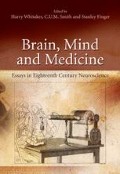In her study “Hysteria: The history of a disease” (1965) Ilza Veith referred to the eighteenth century as “controversial.” It was indeed controversial in that there were competing and changing theories of the nature of hysteria. These depended upon the scientific discoveries and changing theories that influenced medical thought. However, the term “hysteria,” while convenient for the historian, did not reflect the most common usage during the seventeenth and eighteenth centuries.
The term “hysteria” has as its etymology the Greek and Latin term for the womb. However, the Greek physician, Galen (c. AD130–c. 200) noted that “hysterical passion is just one name; varied and innumerable, however, are the forms which it encompasses” (cited in Veith, 1965, p. 39). Indeed, physicians and laymen alike in the seventeenth and eighteenth centuries described the extraordinary behaviors that they witnessed as fits, suffocation of the mother, spleen, vapors, hysteric distemper, nerves, etc. As late as 1788, William Rowley (1742–1806) gave the following title to his work “A Treatise on female, nervous, hysterical, hypochondriacal, bilious, convulsive Diseases …” Thus the term “hysteria” raises problems. As Hunter and McAlpine (1963, p. 288) point out, “The concept of ‘Vapours’ or ‘Hysterick Fits’ which was popular in the later seventeenth and eighteenth centuries illustrates one of the pitfalls of tracing the history of mental illness down the centuries by terminology.” The historian’s difficult task is to find the underlying meanings and theories that underpin the medical language and also to examine and describe some of the different medical practices and therapeutics.
The confusion of ideas, theory, and medical practice during the late-seventeenth and eighteenth centuries coincided with the end to witch hunts, which often involved women who displayed hysteric-like behavior or other signs of mental disturbance. These women had been thought to be possessed by the devil by their inquisitors, sometimes armed with the “Malleus Maleficarum” as a guide.
The changing outlook stemmed from individuals such as Edward Jorden (1578–1632), who became involved in the trial of a woman accused of having put a spell on a 14-year-old girl. In his defence of the “witch,” Jorden argued that the child was suffering from a natural disorder of the mind and behavior. Still, the court found the woman guilty of witchcraft. In 1603, Jorden wrote a treatise to acquaint the medical profession above all, with those behaviors that should be considered clinical signs and not the work of the devil. Thus, new explanations and theories for certain aberrant behaviors began to take hold in the seventeenth century.
Access this chapter
Tax calculation will be finalised at checkout
Purchases are for personal use only
Preview
Unable to display preview. Download preview PDF.
References
Andrée, J. (1746). Cases of the epilepsy, hysteric fits, and St. Vitus dance, with the process of cure. London: W. Meadows and J. Clarke.
Blackmore, R. (1725). A treatise of the spleen and vapours: Or hypochondriacal and hysterical affections. London: Pemberton.
Cheyne, G. (1733). The English malady. London/New York: Tavestock/Routledge.
Cullen, W. (1796). First lines of the practice of physic. Edinburgh: Bell/ Bradfute.
Faber, D. (1997). Jean-Martin Charcot and the Epilepsy/Hysteria relationship. Journal of the History of the Neurosciences, 6(3), 275–290.
Finger, S. (2006). Doctor Franklin’s medicine. Philadelphia: University of Pennsylvania Press.
Fuller, F. (1705). Medicina Gymnastica. London: John Matthews.
Highmore, N. (1670). De pasione hysterica et hypochondriaca, responsio epistolaris ad Doctorem Willis. London.
Hunter, R. & Macalpine, I. (1963). Three Hundred Years of Psychiatry (pp. 1535–1860). Oxford: Oxford University Press.
Jorden, E. (1603). A brief discourse of a disease called the suffocation of the mother. London: John Windet.
Landouzy, H. (1846). Traité Complet de l’Hystérie. Paris: Baillière.
Lange (1689). Traité des Vapeurs. Paris: Denis Nion.
Meninger, K. (1963). The vital balance. New York: Viking Press.
Pinel, P. (1813). Nosographie Philosophique (5th ed.). Paris: J.A. Brosson.
Purcell, J. (1702). A treatise of vapours, or, hysterick fits. London: Newman and Cox.
Risse, G. (1986). Hospital life in enlightenment Scotland. Cambridge: Cambridge University Press.
Risse, G. (1988). Hysteria at the Edinburgh infirmary: The construction and treatment of a disease, 1770–1800. Medical History, 3, 1–22.
Rowley, W. (1788). A treatise on female, nervous, hysterical … diseases. London: Nourse.
St. Clare, W. (1787). Country news. The Gentleman’s Magazine, 57 (Part 1), 1.
Sydenham, T. (1682). Epistolary Dissertation. 1742 Entire Works. J. Swan (Trans.). London: Edward Cave.
Veith, I. (1965). Hysteria: The history of a disease. Chicago: University of Chicago Press.
Wesley, J. (1760). The desideratum: Or, electricity made plain and useful. London: W. Flannel.
Whytt, R. (1767). Observations on the nature, causes, and cure of those dDisorders which have been commonly called nervous, hypochondriac, or hysteric. Edinburgh: J. Balfour.
Willis, T. (1670). Affectionum quae dicuntur hystericae et hypochondriacae. London.
Young, G. (1753). A treatise on opium, founded upon practical observations. London: Millar.
Author information
Authors and Affiliations
Editor information
Editors and Affiliations
Rights and permissions
Copyright information
© 2007 Springer Science+Business Media, LLC
About this chapter
Cite this chapter
Faber, D. (2007). Hysteria in the Eighteenth Century. In: Whitaker, H., Smith, C.U.M., Finger, S. (eds) Brain, Mind and Medicine: Essays in Eighteenth-Century Neuroscience. Springer, Boston, MA. https://doi.org/10.1007/978-0-387-70967-3_23
Download citation
DOI: https://doi.org/10.1007/978-0-387-70967-3_23
Publisher Name: Springer, Boston, MA
Print ISBN: 978-0-387-70966-6
Online ISBN: 978-0-387-70967-3
eBook Packages: Biomedical and Life SciencesBiomedical and Life Sciences (R0)

